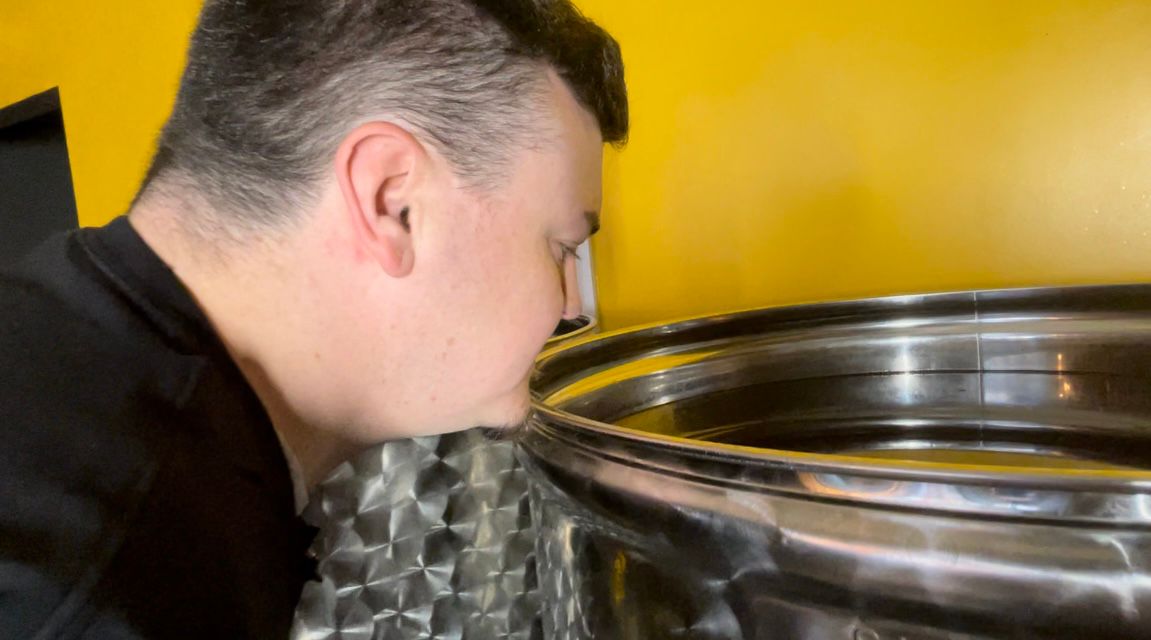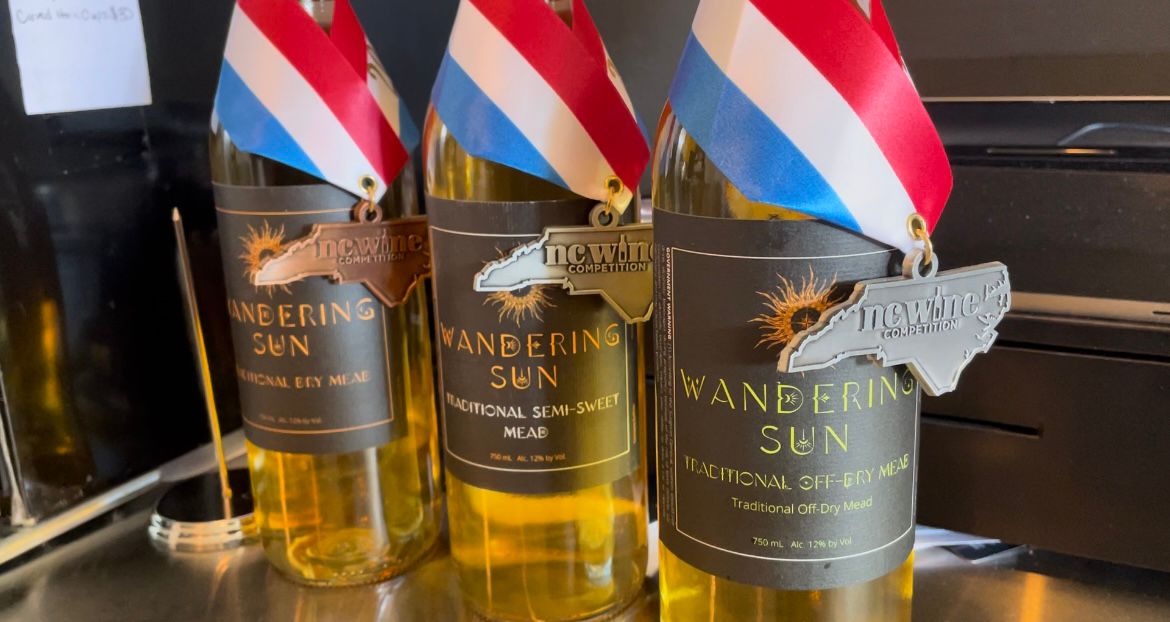From spectrumlocalnews.com
MADISON, N.C. — The oldest known alcohol in the world is mead. It’s made of honey, yeast and water and has gained popularity from medieval-style shows such as "Game of Thrones" and the "Lord of the Rings" movie series.
What You Need To Know
- Mead is the oldest known alcoholic beverage in the world
- It is made of honey, yeast and water
- Mead is gaining popularity through medieval shows and movies
It’s called the nectar of the gods and with at least 16 meaderies across the state, the golden-coloured drink is making a statement across North Carolina.
Trevor Ogle is the co-owner and mead maker at Wandering Sun Meadery, and after studying in Kazan, Russia, he fell in love with mead.
“When I was in Russia, I found a lot of mead. And I was really excited about it, because I tried it. It was really good. Then I got back here, and you couldn't find it anywhere,” Ogle said.
Ogle has lived many lives from being in a 1980s and '90s tribute band, a teacher and studying pre-med and Russian. Using all of this knowledge, he is able to make the best version of his mead possible.
“Oh, this is definitely basic basic biochemistry. That's what brewing is. So just chemistry and biology together. Chemistry and biology together makes this work, makes it a lot easier, makes you kind of understand more what you're doing and why you're doing it,” Ogle said.
He says the process starts like any alcoholic drink, with the fermentation process his favourite part.
"It's just really neat," Ogle said.
For 500 litres of mead, he says he uses around 360 pounds of local honey from the Rockingham and Stokes County areas.
“You get the fermentation so strong that you open up one of those larger tanks, and it just looks like there's a propeller at the bottom stirring everything up, and nothing's going on. It's so strong that the yeast are putting out alcohol and carbon dioxide that it literally just churns it as if there's like a propeller in there,” Ogle said.
He says his mead can be ready in about two to two and a half weeks, far from the common misconception about the ancient beverage.
“There's this myth that you can't drink a mead until it's a year old, and that is totally a myth,” Ogle said.
 Trevor Ogle smelling the fermentation process of his mead. (Spectrum News 1/Sydney McCoy)
Trevor Ogle smelling the fermentation process of his mead. (Spectrum News 1/Sydney McCoy)After a good sniff test, he knows his mead is ready for the next step.
“It gets up to 12%. At that point, we can clarify it and filter it to make it nice and clear and take the yeast back out of it. And after it's clarified, we will put it into separate containers and flavour it up with spices, herbs, fruits, whatever we want,” Ogle said.
Ogle says it's important to make sure his equipment is clean to help enhance the flavour and quality of the mead. But if any stray bacteria or yeast gets left behind, the fermentation process can ruin the product.
“There's an old joke that if you want to own a meadery, winery, brewery, you get used to washing dishes, because that's pretty much all you're going to do,” Ogle said.
After more filtration, the mead is ready for bottling.
He says he makes a pretty mean orange blossom traditional, and some of his favourite flavours are his custom Viking, Pineapples of Paradise and says his best is probably his traditionals.
“So I think my honestly, my best are my traditionals. Traditional mead is notoriously difficult to make because there's nothing really in it. It's just honey, yeast and water. And so it can be very challenging," Ogle said.
He says his secret is keeping the mead flavour in it, which is what makes it unique.
“I think it's just a good solid mead and has a good mead flavour. There was a mead judge that actually came by one time to try to mead, and he said that was the mead-est mead that he had ever tasted,” Ogle said.
 Medals won by Wandering Sun Meadery earlier this year. (Spectrum News 1/Sydney McCoy)
Medals won by Wandering Sun Meadery earlier this year. (Spectrum News 1/Sydney McCoy)Regardless of what flavour of mead you may try, one thing is for sure, mead is neither a wine nor a beer.
“And it's really its own beverage. So that makes it kind of stand out. It has a flavour that is kind of like a wine, but it really is completely unique,” Ogle said.
He says its uniqueness makes the drink appeal to the masses and says you just have to try it!
“It’s kind of a combo, it's its own thing. Yeah. It appeals definitely to beer drinkers. It appeals to wine drinkers. It appeals to people that like sweet wine. People like dry wine, because you really can't make it kind of anywhere you want,” Ogle said.
Wandering Sun Meadery has won numerous awards, including silver medals for its traditional off-dry mead and semi-sweet mead, as well as a bronze medal for its traditional dry mead at the 2023 NC Wine Competition.
https://spectrumlocalnews.com/nc/charlotte/news/2023/09/22/wandering-sun-meadery-mead-
It’s called the nectar of the gods and with at least 16 meaderies across the state, the golden-coloured drink is making a statement across North Carolina.
Trevor Ogle is the co-owner and mead maker at Wandering Sun Meadery, and after studying in Kazan, Russia, he fell in love with mead.
“When I was in Russia, I found a lot of mead. And I was really excited about it, because I tried it. It was really good. Then I got back here, and you couldn't find it anywhere,” Ogle said.
Ogle has lived many lives from being in a 1980s and '90s tribute band, a teacher and studying pre-med and Russian. Using all of this knowledge, he is able to make the best version of his mead possible.
“Oh, this is definitely basic basic biochemistry. That's what brewing is. So just chemistry and biology together. Chemistry and biology together makes this work, makes it a lot easier, makes you kind of understand more what you're doing and why you're doing it,” Ogle said.
He says the process starts like any alcoholic drink, with the fermentation process his favourite part.
"It's just really neat," Ogle said.
For 500 litres of mead, he says he uses around 360 pounds of local honey from the Rockingham and Stokes County areas.
“You get the fermentation so strong that you open up one of those larger tanks, and it just looks like there's a propeller at the bottom stirring everything up, and nothing's going on. It's so strong that the yeast are putting out alcohol and carbon dioxide that it literally just churns it as if there's like a propeller in there,” Ogle said.
He says his mead can be ready in about two to two and a half weeks, far from the common misconception about the ancient beverage.
“There's this myth that you can't drink a mead until it's a year old, and that is totally a myth,” Ogle said.

After a good sniff test, he knows his mead is ready for the next step.
“It gets up to 12%. At that point, we can clarify it and filter it to make it nice and clear and take the yeast back out of it. And after it's clarified, we will put it into separate containers and flavour it up with spices, herbs, fruits, whatever we want,” Ogle said.
Ogle says it's important to make sure his equipment is clean to help enhance the flavour and quality of the mead. But if any stray bacteria or yeast gets left behind, the fermentation process can ruin the product.
“There's an old joke that if you want to own a meadery, winery, brewery, you get used to washing dishes, because that's pretty much all you're going to do,” Ogle said.
After more filtration, the mead is ready for bottling.
He says he makes a pretty mean orange blossom traditional, and some of his favourite flavours are his custom Viking, Pineapples of Paradise and says his best is probably his traditionals.
“So I think my honestly, my best are my traditionals. Traditional mead is notoriously difficult to make because there's nothing really in it. It's just honey, yeast and water. And so it can be very challenging," Ogle said.
He says his secret is keeping the mead flavour in it, which is what makes it unique.
“I think it's just a good solid mead and has a good mead flavour. There was a mead judge that actually came by one time to try to mead, and he said that was the mead-est mead that he had ever tasted,” Ogle said.

Regardless of what flavour of mead you may try, one thing is for sure, mead is neither a wine nor a beer.
“And it's really its own beverage. So that makes it kind of stand out. It has a flavour that is kind of like a wine, but it really is completely unique,” Ogle said.
He says its uniqueness makes the drink appeal to the masses and says you just have to try it!
“It’s kind of a combo, it's its own thing. Yeah. It appeals definitely to beer drinkers. It appeals to wine drinkers. It appeals to people that like sweet wine. People like dry wine, because you really can't make it kind of anywhere you want,” Ogle said.
Wandering Sun Meadery has won numerous awards, including silver medals for its traditional off-dry mead and semi-sweet mead, as well as a bronze medal for its traditional dry mead at the 2023 NC Wine Competition.
https://spectrumlocalnews.com/nc/charlotte/news/2023/09/22/wandering-sun-meadery-mead-
%20Matt%20&%20Kit%20Newell%20receive%20the%20Wales%20Golden%20Fork%20award%20-%20Credit%20Guild%20of%20Fine%20Foods.JPG.gallery.jpg)

